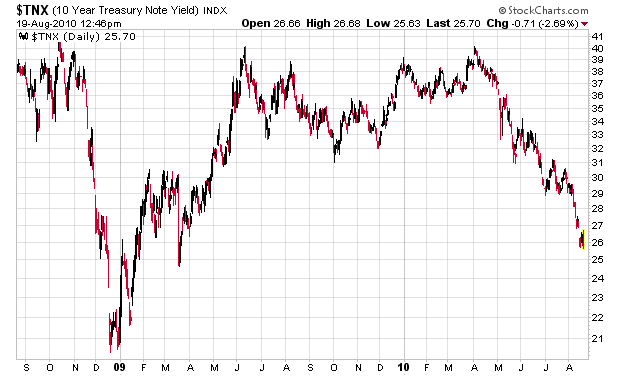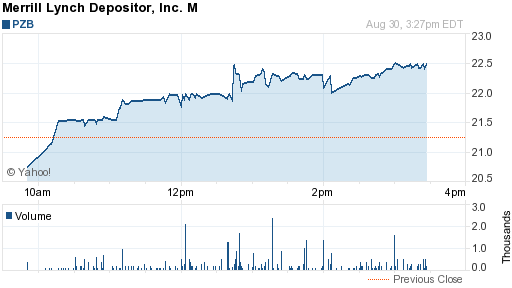Every analyst that is actively tracking the market is acutely aware that the US government bond (and this also applies to Canadian government bond) yields have been dropping dramatically over the past couple months. Here is a chart of the 10-year US Treasury note yield over the past two years (the y-axis is the percent yield times 10):

What do we see?
People that loaded up on government debt four months ago are laughing right now since they have a significant profit. But should they liquidate? What is the market anticipating? (Just as a side note, I don’t apply my “August trading is not to be taken seriously” stance on the government bond market.)
Typically institutions invest in bonds if they anticipate deflation (as having a fixed income yield in a deflationary situation is ideal) or if there is a “flight to safety” or some incident that spooks the market – such as a global economic crisis that occurred in late 2008/early 2009. Bond yields went as low as around 2.0% at that point in time.
But where is the global economic crisis today? It is obvious the market is trying to say something is going to happen, and I believe the bet is on some sort of deflation.
Even though I believe the next “swing” in monetary trends will be an inflation, this will only happen when the vast quantity of money supply out there is unleashed into the economy – right now those reserves are being held by banks that are very resistant to lending them because of credit concerns. They don’t want a repeat of late 2008, so they are buffering themselves. The catalyst to lending will be confidence in the marketplace, and right now is the most business-unfriendly administration the US has ever seen in a long, long time. Until this administration is gone and replaced by a pro-business administration, investors will not have the confidence. However, that will be the catalyst for inflation.
So until then, we might be seeing a deflationary dip as government stimulus slows down and the economy comes grinding to a halt. I don’t think we will be entering into a “new depression” by any means, but economic growth is going to be slow.
What are the implications?
1. Federal funds rates will be kept at zero for a long time. December 2011 futures are trading at 0.45%. In Canada, I would expect one more rate increase of 0.25% to 1.00% in September, and that is it for now.
2. People will struggle to find yield at an acceptable price. You can’t invest in the short-end of the rate curve, since this yields almost nothing (two-year government bonds give you less than 0.5%!). This already has been happening, especially since the last four months. Gold is also popular, which is counter-intuitive since assets decline in deflationary situations – I believe the mentality is that “bond rates are low, Gold will return nothing, but it will retain its value since it is a de facto quasi-currency.” Other commodities, such as oil, copper, etc., should depreciate unless if they also have a quasi-currency perception by the marketplace. Note that America’s economy used to dominate the commodity market, but with emerging markets (e.g. China, India, Brazil in particular) taking a higher proportion of commodities, the linkage might change somewhat.
3. Companies with debt will find financing a little tricky if they are too leveraged – low interest rates are “good” since they will be able to pay less interest on debt, but this is assuming they get extended credit since their cash-generation ability will be compromised by the deflation itself.
4. In a deflationary situation, zero-yield cash also has a positive return at the rate of the deflation itself. Any savings banks that give a positive yield (e.g. Ally at 2%) is “gravy” on top.
How low will the 10-year note yield go? I have no idea. However, at current yields, 2.6% looks very pricey compared to other alternatives that are available. It takes a very brave person to be shorting these products since it is very well believable that you could see even lower yields.
I do know when this paradigm changes to the inflationary cycle that it will be very quick – like a flash forest fire.


